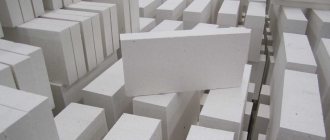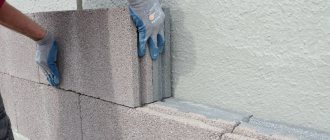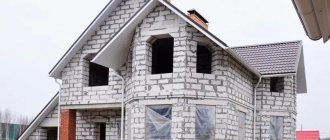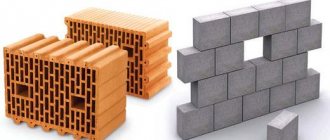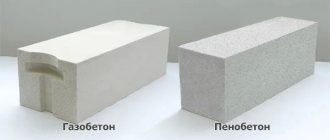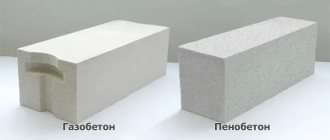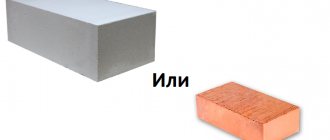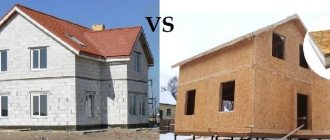Beton-House.com
Website about concrete: construction, characteristics, design. We combine the experience of professionals and private craftsmen in one place
Selecting blocks for construction
At the moment, the problem of choosing the optimal material is most relevant for developers, especially taking into account the large range of products with different compositions and properties.
In this article we will compare block-type products intended primarily for the construction of walls. Let's figure out what is better: cinder block or aerated concrete?
- Specifications
- Production of aerated concrete
- Tips for constructing cinder block buildings
What is cinder block
Before moving directly to the comparison, it is necessary to carefully study the characteristics and qualities of both materials, and we will begin, perhaps, with a cinder block.
Cinder block, photo
Main characteristics
Cinder block is a modern building material that is produced by vibration pressing or through the process of natural shrinkage in molds with mortar. The most popular filler, in this case, is slag. In most cases, cement is used as the main binder.
In addition to slag, they can also use: crushed stone, broken cement or brick, gravel, sand, granite screenings and other similar materials. The type of filler directly affects the characteristics of products, such as environmental friendliness, frost resistance, and strength.
Let's look at the main properties of this material using a table.
Specifications:
| Characteristic name | Its meaning | Comments |
| Thermal conductivity, W/m C | 0,3-0,5 | The indicator is quite good, but the walls still require insulation. It is typical for stones with a density of 1000-1200 kg/m3 |
| Frost resistance, cycles | 15-25 | This indicator indicates how many alternating number of freezing and thawing cycles the material can withstand. |
| Moisture absorption | Up to 75% | This is a very high indicator, which indicates that the products need protection from the harmful effects of moisture. |
| Strength, kg/cm2 | 25-150 | This strength is quite sufficient for the construction of low-rise buildings. |
| Fire resistance | Up to 800 degrees | The material is not flammable. It can withstand high temperatures, but does not interact with fire. |
| Average density, kg/m3 | 500-1000 | The material is quite durable. |
| Shrinkage | — | This material is not characterized by shrinkage, which undoubtedly adds to its advantage. |
| Sound insulation, dB | 40-43 | This indicator indicates the level of noise that can penetrate a wall one block thick. In this case, the products are inferior to many other wall materials. |
| Number of floors of the building | Maximum - 3 | The strength of the block does not allow the construction of buildings with more floors. |
Types and scope of application
Cinder blocks are classified according to their brand according to their strength. Its numerical indicators vary from 35 to 125 kg/cm2.
Depending on the above, cinder blocks are divided into:
- Products with a strength of 35. They are used as insulation or in the construction of fences. Such material cannot withstand significant loads;
- Material density 50-75. Used in the construction of walls and partitions;
- Products with a density of 100-125 are the most durable. They can be used when constructing foundations and plinths.
Cinder blocks are also divided depending on the type of filler. In accordance with this, products are:
- Slag-based products. The most popular filler. When choosing products, you should be extremely careful, since the environmental friendliness of the material depends on the filler.
- Cinder blocks made using wood concrete (material based on sawdust). Such products are most susceptible to moisture. Their durability is comparatively less. Thermal insulation characteristics are high.
- Cinder blocks made from expanded clay. According to experts, this is the best type of cinder block. They are environmentally friendly, durable and have a low thermal conductivity coefficient.
Depending on the hollowness, cinder blocks are distinguished: solid and hollow. The first types of products are used in the construction of foundations, plinths and other load-bearing structures. Such blocks are the most durable.
Hollow products are used in the construction of partitions and walls. The properties and characteristics of such a block directly depend on the percentage of voids and the type of internal cavity.
- A cinder block with a hollowness of up to 40% is the least durable, however, at the same time. It has high thermal insulation characteristics. It is used mainly for insulating buildings.
- Products with a hollowness of 30% have an optimal combination of strength and thermal conductivity. They are most common among developers.
- The above products are produced with oval, round, rectangular cavities. The most convenient for construction are blocks with rectangular cavities, while those with round and oval cavities are considered more durable.
- It is worth noting that the assortment of cinder blocks includes products with decorative cladding, as well as torn and chipped textures.
Competitive advantages and disadvantages
Like any other material, cinder block is not without strengths and weaknesses, which we will now consider.
Let's start with the positive qualities:
- Relatively low price. This is a significant advantage for many.
- The dimensions of the products are quite large, which allows the building to be erected in a short time.
- The installation technology is simple; almost anyone can do it with their own hands.
- The ability to choose a suitable filler can also be considered an advantage of the material.
- The products are durable, their service life can reach 100 years.
- Availability of blocks with decorative cladding.
- The low weight of the products allows the construction of buildings on a lightweight foundation in some cases.
- Possibility of finishing cinder block walls with almost any material. In this case, it is only worth considering the combination of materials for internal and external cladding from a technical point of view.
- Another advantage is the ability to make products yourself at home, for this you only need instructions.
The disadvantages include:
- Questionable environmental friendliness. As already mentioned, this indicator depends on the filler of the products.
- The geometry of a cinder block sometimes leaves much to be desired. When purchasing material, you should pay special attention to it. Sawdust-based blocks lose more than others in this indicator. Expanded clay cinder blocks are somewhat better.
Note! When purchasing products with irregular geometry, you will expect additional costs for laying and finishing the walls.
- High level of moisture absorption. These products absorb moisture quite strongly, and therefore need protection from it. This fact should definitely be taken into account when finishing finished walls.
- The material is fragile, it is easily subject to mechanical stress.
- The frost resistance indicator is relatively low. However, with the use of specialized additives it can be somewhat improved. But, if you compare products with other materials, cinder block is far from being in the first positions.
Reviews
- Alexander: “When building the garage, I used mainly foam blocks, since there are doubts about the quality of cinder block materials. The outside still has to be insulated, if only for reasons of aesthetics of the building. In terms of cost, of course, it hit the pocket a little, but the garage was designed for more than one year of use. In general, my sympathies are exclusively on the side of foam blocks.”
- Vladimir: “I used both materials in the construction of the country house. The calculations were made by an experienced builder, so there is no doubt. For especially important and load-bearing structures, cinder block was used, since it is much stronger and heavier. Foam block was also used, but for the veranda and intermediate walls. It turned out well, we haven’t tested it with time yet (the construction was recently completed), but I hope everything will be fine. I plan to live in the house permanently in the summer and periodically heat it on weekends. It seems like everything should be fine, but winter will tell.”
You may also be wondering what is the difference between aerated block and foam block. Also read which is better: foam block or gas block. The pros and cons of gas blocks are described here, and the properties of gas blocks are described here.
The concept of aerated concrete, its types and properties
Aerated concrete is an extremely popular material, which is directly related to its set of properties and qualities. Let's look at which of them are the reason why an increasing number of developers prefer to build their buildings using aerated concrete.
Specifications
Let's look at the table and analyze the indicators.
Properties and qualities of aerated concrete:
| Name | Meaning | Comments |
| Thermal conductivity | From 0.09 to 0.38 | These values are typical for dry products. With operating humidity, this figure can increase significantly. In this case, the release humidity of products should not exceed 25% for sand-based materials and 30% for ash products. We will consider the dependence of thermal conductivity on the strength of products below. |
| Frost resistance | Up to 150 cycles | The minimum value for blocks used for the construction of external walls should not be less than 25 in accordance with GOST, and for the rest - not less than 15. Some manufacturers claim that an aerated block can withstand up to 150 freezing and thawing cycles. |
| Density | 300-1200 | These indicators are established by GOST. Depending on the density, there are several types of aerated concrete. |
| Strength grade | From 1.5 to 12.5 | The material is strong enough to be used to construct buildings several stories high. |
| Shrinkage | 0.3 mm/m2 | Shrinkage is a problem with many wall materials and is also common with aerated concrete. |
| Water absorption | 25% | The material absorbs moisture quite strongly. This is the main drawback. |
| Environmental friendliness | 2 | If we compare aerated concrete with wood, then for the latter this indicator is 1, and for aerated concrete it is 2. |
Structure of aerated concrete
Classification
In accordance with GOST, aerated concrete has several classifications related to various factors. Let's take a closer look at them.
Depending on the hardening method, aerated concrete can be autoclaved or non-autoclaved. At the last stage of production, autoclaved aerated concrete is processed in special equipment - an autoclave, under the influence of high temperature and pressure, the products harden and gain brand strength.
Non-autoclaved aerated concrete hardens under natural conditions; sometimes it is heated using special machines to a low temperature in order to speed up the process. This material reaches brand strength after 28 days.
Autoclaved and non-autoclaved aerated concrete
Depending on the strength of the products, aerated concrete is divided into:
- Structural;
- Thermal insulation;
- Structural and thermal insulation.
External differences between aerated concrete of different strengths
- The first type is the most durable, the indicator varies from 1000 to 1200. It is used in the construction of buildings up to 12-15 meters high. It needs additional insulation, since the thermal conductivity coefficient also increases along with strength.
- Thermal insulating aerated concrete is the least durable, with an index of 300-400. It is used exclusively for the purpose of insulation, since it cannot withstand any loads other than its own weight.
- Structural thermal insulating aerated concrete is an ideal combination of thermal conductivity and strength. Such products are most popular among private developers. It is used in the construction of walls and partitions.
Let's look at the table.
Dependence of density and thermal conductivity coefficient:
| Type of aerated concrete | Density | Dry thermal conductivity |
| Structural | 1000-1200 | 0,29-0,34 |
| Thermal insulation | 300-400 | 0,09-0,12 |
| Structural and thermal insulation | 500-900 | 0,13-0,28 |
Another classification is based on the type of silica component.
Products can be manufactured on:
- Sand, more often quartz;
- On the ashes;
- On other industrial waste.
Products are divided according to the type of binder:
- On lime binder;
- On cement;
- On the sand;
- On slag;
- On a mixed binder;
- On ash.
Differences in geometric deviations also made it necessary to classify products.
Depending on the accuracy category, gas blocks are:
- First category of accuracy;
- Second category of accuracy;
- Third category of accuracy.
Note! Blocks of different categories differ from each other only by permissible deviations. Their technical and mechanical characteristics are similar and may differ only due to their affiliation with one manufacturer or another.
Let's consider the table of permissible deviations in accordance with GOST.
Geometric deviations of products:
| Deviation | 1 category | 2nd category | 3 category |
| To size | No more than 1.5 mm | No more than 2 mm | No more than 4 mm |
| Diagonally | 2 mm | 3 mm | 6 mm |
| Broken corners | 5 mm | 5-7 mm | 10 mm |
| Edge violations | 3 mm | 4 mm | 8-10 mm |
Note! Products that are characterized by exceeding these deviations should not exceed 5% of the batch for each indicator.
Strengths and weaknesses of products and buildings built from them
Now it’s time to consider the advantages and disadvantages of aerated concrete and products made from it.
The advantages boil down to the following:
- The material is lightweight, which can significantly reduce the load on the foundation.
- Large dimensions will significantly speed up the process of building construction.
- The material is made from a mixture of lime, cement, sand, aluminum powder and water. None of the materials are toxic and do not emit harmful substances. As a result, the products are environmentally friendly.
- Aerated concrete does not burn and does not interact with fire.
- Strength and thermal conductivity indicators are the most optimal. They allow you to build buildings several floors high and, at the same time, save on insulation.
- Frost resistance is at a high level. As already mentioned, the material can withstand up to 150 cycles.
- Variability of external and internal decoration. Walls made of aerated concrete can be finished with almost any material, subject to compliance with technological rules.
- Aerated concrete is easy to use. It can be sawed, sanded, cut. This does not require a highly specialized tool. You can get by with a regular saw or hacksaw.
- Almost anyone can install products.
- The durability of buildings built from aerated concrete reaches 200 years.
- The prevalence of the material among manufacturers and first suppliers makes it possible to find a dealer located nearby and, thereby, save on delivery.
Advantages of aerated concrete
The main disadvantages of the material:
- The most important thing is the hygroscopicity of aerated concrete. It absorbs moisture quite strongly, which makes it more vulnerable. If it crystallizes, the block risks being resolved from within.
The disadvantage can be mitigated by technically correctly executed finishing.
- Fixing elements is one of the difficulties that may arise during the construction of a house. Particularly heavy elements that have a high level of tearing must be secured, of course. It is possible, however, the fixation points will have to be planned at the project level and reinforced in advance with stronger materials. It could be brick or metal.
Less heavy objects can be fastened using specialized hardware designed for products made of cellular concrete.
- Aerated concrete is fragile. It does not tolerate mechanical stress. Chips and cracks may appear as a result of careless transportation or careless attitude during work.
- Shrinkage is another disadvantage. Cracks often appear on the products themselves, as well as on the plaster that has already been applied.
- The presence of handicraft production of non-autoclaved aerated concrete increases the possibility of purchasing low-quality products.
Note! Before purchasing material, always ask the seller (supplier) to demonstrate quality certificates for the products. This will protect you from unsuccessful purchases.
Aerated concrete has no more significant disadvantages.
Density
The density of aerated blocks, which are most often used in construction, is 500-900 kg/m3 . For cinder blocks, the average density is slightly higher - 800-1300 kg/m3 .
What does this mean in practice?
Cinder blocks are slightly heavier than aerated concrete blocks. Accordingly, the load on the foundation will also be greater. But it is worth noting that this difference is not fundamental and to build a house up to 2 floors high, strengthening the foundation will not be required (unlike a brick house).
Overview of the main differences and similarities of materials
And now that we have already examined the characteristics of both materials, let’s try to figure out what is better: aerated concrete or cinder block? Let's use the table.
Cinder block or aerated concrete: choosing the winner:
| Indicator or characteristic | Comments |
| Thermal conductivity | In this indicator, aerated concrete definitely wins. This is due, first of all, to its lower density compared to cinder block. |
| Frost resistance | The frost resistance of aerated concrete is also higher, two to three times, depending on the manufacturer. |
| Shrinkage | But when comparing the shrinkage rate, the palm belongs to the cinder block. He doesn't sit down. But aerated concrete can even crack as a result of this phenomenon. |
| Moisture absorption | Both materials strongly absorb moisture and therefore require technically correct finishing in order to prevent its detrimental effect on the products. |
| Strength, density | Cinder block is somewhat more durable, but not by much. |
| Variability of finishes | Walls made from both products can be finished with almost any material. |
| Construction speed | Since both cinder block and aerated concrete are large in size, the construction speed of both is high. Depending on the size, the blocks can replace a laying of up to 15 bricks. Agree, the process will happen much faster. |
| Difficulty of construction | Special difficulties during construction usually do not arise if you do not take into account the mandatory reinforcement. |
| Ease of material processing | Both cinder block and aerated concrete are easy to process. They are easy to cut and sand. |
| What is cheaper: aerated concrete or cinder block? | Cinder block is somewhat cheaper. |
| Complexity of production | The technology for producing materials is not complicated. Moreover, non-autoclave options can be made at home without significant expense. In this case, you can even partially build the equipment yourself. |
| Scope of application, popularity among developers | Aerated blocks are often used in the construction of house walls, and cinder blocks are used for the construction of basements and plinths. The scope of application for both materials is quite wide. It is worth noting that aerated concrete is also used in liquid form. For example, for installing a screed or base under a warm floor, for insulating a roof. |
Despite the fact that aerated concrete wins in many respects, it is still difficult to say which is better. Since a lot depends on what qualities are most important for the developer and what individual requirements he places on the material for building walls.
Brick
It is the most popular building material. Its advantage is that it is light, durable and brick buildings are usually durable. It is not at all difficult to create decorative elements from it and erect buildings of intricate configurations.
And of course, this material, along with its pros, also has its cons. It is not moisture resistant, which leads to the formation of dampness in the room. To prevent dampness, the walls need to be built thick.
It has a special heat capacity, but this is also its disadvantage. If your home has not been heated for some time, it will be quite difficult to warm it up.
Step-by-step analysis of manufacturing technology
Now let's take a look at the production technology of both materials, maybe this will help us choose a more suitable option.
Production of aerated concrete
To produce aerated concrete you will need some equipment.
There may be several options:
- Conveyor line. It is almost completely automated and does not require a large number of personnel; you only need to hire several operators. Such a line will provide high production speed and fairly large production volumes. The price for it is appropriate.
- Landline line. More budget option. You can choose the package yourself, however, the final result will depend on it. The production volume can also be large, but the speed will be slightly lower.
- Mini production line. Suitable for the production of non-autoclaved aerated concrete at home or for sale by small businesses. Does not require large areas and significant costs. However, its productivity is low.
- Cement grade not lower than M400;
- Quartz sand;
- Aluminum powder or paste;
- Pure water;
- Quicklime;
- Additives are also used to increase the hardening speed and improve quality indicators.
The work process contains the following stages:
- The solution is mixed;
- The solution is placed in molds in which it swells and pores form;
- After partial hardening, the products are subjected to turning and cutting into standard sizes. When making at home, the mixture is poured into a mold already divided into sizes.
- At the last stage, the blocks are processed in an autoclave or, in the production of hydration-hardening aerated concrete, dried under natural conditions. The latter gains strength after 28 days.
After 7-10 days, the formwork is usually removed.
Release of cinder block
Cinder block, just like aerated concrete, can be produced in a factory or independently.
To start working at home you will need:
- Vibropressing equipment;
- Sand;
- Cement;
- Filler in the form of slag or its substitute.
Vibropress
When manufacturing the material, the following must be taken into account:
- The most durable are cement-based blocks, the next most durable are lime products;
- If you replace some of the granules with sifted sand, the strength indicators will increase slightly;
- Before you start filling the molds with the mixture, you need to prepare them: clean them of dust and dirt, treat them with a special compound to prevent the products from sticking to the walls of the molds;
- The thicker the solution, the faster the products will harden. Indicators of the quality and properties of finished products depend not only on the production method, but also on the composition of raw materials and their proportions.
The standard recipe for a cinder block solution looks like this:
- Slag – 7 parts;
- Sand – 2 parts;
- Gravel - 2 parts;
- Cement – 1.5 parts;
- Water -1.5-3 parts.
Let's briefly consider the work process:
- The prepared solution is placed in molds and the vibrator is turned on. Next, set the clamp and process the solution again using a vibrator until the clamp settles. If there is not enough solution, it is reported. When the clamp sits on the stops, the formation can be considered complete.
- The vibroforms are restarted for approximately 15 seconds, after which the products are removed. In this case the car is not turned off.
- The blocks are dried for 5-7 days. They reach brand strength after approximately 4 weeks. In this case, the room should have high humidity, and the air temperature should not be cold.
- If you add a plasticizer to the solution, then after 8-20 hours the blocks can be stored.
- In its absence, storage is possible only after one week.
Do-it-yourself cinder block filling with mortar
In factory production, as in the case of aerated concrete, everything happens in a more automated mode with minimal human intervention.
Automated equipment for cinder block production
The video in this article contains information about the stages of product production.
Features of masonry work
Despite the fact that the materials have similarities, the masonry of each of them has its own characteristics. Let's figure it out. What is the process of constructing a building from slag and gas blocks?
Tips for constructing cinder block buildings
When building using this material, you should follow some rules that will help avoid unpleasant consequences.
They boil down to the following:
- Masonry work should be carried out in the warm season in the absence of precipitation;
- The first row should be on an elevated foundation, more than 0.7 meters high;
- You shouldn’t delay finishing the walls; they should soon be protected from moisture;
- The installation of the roof should also be carried out immediately after completion of the work for the same purpose.
Stages of wall construction:
- The laying begins with setting the corners, which is done using rows. A thread is stretched between them, serving as a guide.
- The most important row is the first; its installation must be approached with all responsibility. The adhesive mixture is applied in a thin layer, using a trowel. After laying three blocks, they must be checked for evenness and, if necessary, adjusted. It is recommended to do this as often as possible in order to eliminate errors.
- Subsequent layers are laid in the same way as the seam is offset. All cracks must be filled with mortar.
Note! If hollow blocks are used, the holes should never be filled with mortar. This will lead to loss of high thermal insulation properties.
Stages of construction of aerated concrete walls
The process of laying aerated concrete blocks is extremely similar to laying cinder blocks.
Let's take a quick look:
- The first blocks are placed in the corners and a thread is pulled between them.
- The first layer is laid on the mortar for better adhesion to the base and strengthening the structure. It is recommended to lay subsequent rows on glue, maintaining a thin layer, in order to reduce cold bridges.
- The base must be level!
- After installing the blocks in the corners, begin laying the entire row. If a gap remains, the block is cut to the required size.
- Adjustments are made using a level and a rubber hammer.
- When laying the first and every 4th row, reinforcement is performed.
- The second and subsequent rows are laid with the seam offset.
- After erecting the wall, it is necessary to install an armored belt.
Dimensions
The standard size of a gas block is 600x300x200 mm . 1 m3 contains 28 individual blocks of this size. The standard size of a cinder block is 390x190x188 mm . 1 m3 contains 72 individual blocks of this size.
What does this mean in practice?
A building made of aerated concrete can be built 2 times faster : for a house 10x10 meters you will need approximately 840 aerated concrete blocks and 2160 cinder blocks.
Calculation of aerated concrete blocks and glue
| ROOM PARAMETERS: | |
| Wall height (m): | |
| External walls: | |
| Density class: | |
| Wall length (perimeter) (m): | |
| Thickness of walls (block)*: | |
| Area of door and window openings (m2): | |
| PARTITIONS: | |
| Density class: | |
| Length of partition walls (perimeter): | |
| Thickness of partition walls: | |
| Area of door and window openings (m2): | |
| Total per room: | |
| APPROXIMATE VOLUME OF BLOCKS: 0 m3 | |
| VOLUME OF PARTITIONS: 0 m3 | |
| NUMBER OF GLUE BAGS**: 0 pcs. | |
| * - wall thickness according to the project ** - glue consumption: 25 kg per 1 m3 of aerated concrete blocks with an adhesive layer thickness of no more than 3 mm and block size 600x375x250. | |
Main results
Do you want to save money? Choose a cinder block or even try your hand at making it yourself. And if the decisive factors for you are frost resistance and environmental friendliness, for example, choose a gas block.
So which is better, aerated concrete or cinder block? Everyone must determine for themselves which parameters are the most important. Indeed, despite the similarities, these materials also have differences that directly affect the strength, durability and performance characteristics of the structure.

